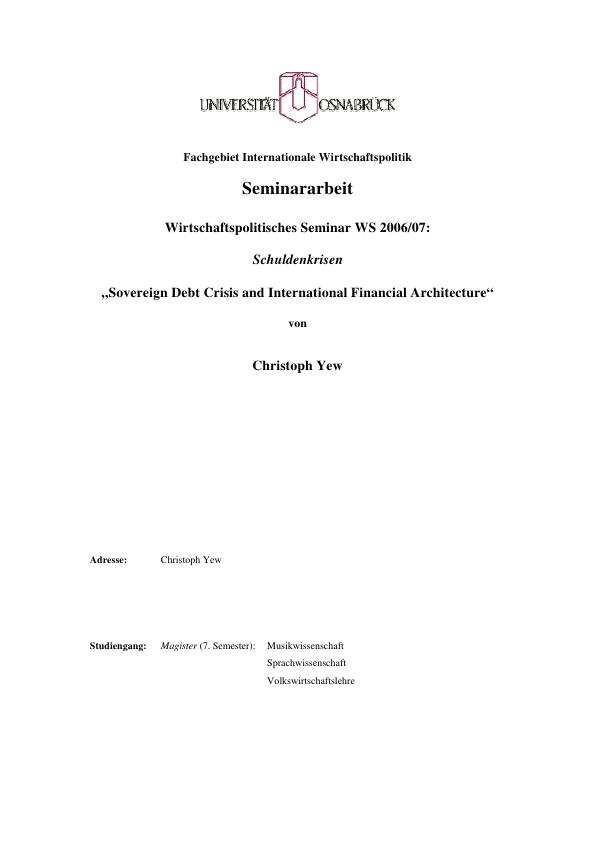If we have a look at the composition of total debt of different countries it is easy to
see (Figure 1.2) that from 1992 to 2002 the advanced countries’ total debts mainly
consisted of domestic currency, whereas those of emerging market countries where
mainly borrowed in foreign currency. If we focus our view on sovereign debt only,
this difference vanishes. From 1980 to 2003 about 99.7 percent (Table 1) of sovereign
debt in emerging market countries was borrowed in foreign currency. In advanced
economies it was slightly less (92.5%). Nevertheless, in both cases the U.S. dollar was
the dominating foreign currency. A reason for this might be that this currency is
considered as very important in international trade.
A comparison between these facts leads me to the conclusion that private persons in
advanced countries trust their own currency, whereas private persons in emerging
market economies seem to trust foreign currencies. Otherwise the currency
composition between total debt and sovereign debt would not differ so much from
each other. Another interesting fact concerns which other currencies states prefer to
borrow in. They like advanced economies’ currencies instead those of emerging
market countries.
Another important point concerning public debt structure is their composition
structure concerning maturity. It can be seen (Figure 4.2) that during 1988 the average
maturity of sovereign debt issued in both kinds of countries was little below 8 years.
But during the following 14 years the average maturity rate in emerging market
countries decreased to about 5 years while the maturity rate of advanced countries
sovereign debt increased to almost 10 years. This tendency towards short-term debt
can also be seen on Figure 4.1. It is interesting to note the fall in 1999 in both markets
(Figure 4.2) which was nevertheless stronger in emerging countries.[...]
Inhaltsverzeichnis (Table of Contents)
- Introduction
- Structure of Debt
- Foreign Currency and Debt
- Maturity Composition of Sovereign Debt
- Jeanne's Model
- Assumptions
- Debt Maturity
- Equilibrium
- Renegotiation-friendly Clauses
- International Financial Architecture
- Famous Recent Crises
- The Tequila Crisis
- The Asian Crisis
- What Happened Then
- Reforming the IFA
- Crisis Prevention
- Crisis Treatment
- International Lender of Last Resort
- Crisis Insurance Fund
- Standstills
- IMF & IFA
- Famous Recent Crises
- Conclusion
Zielsetzung und Themenschwerpunkte (Objectives and Key Themes)
This paper examines the structure of sovereign debt, particularly focusing on the prevalence of foreign currency debt in emerging market economies. The paper analyzes the reasons behind this phenomenon and explores how debt structure influences sovereign debt crises. Drawing upon Olivier Jeanne's model, the paper investigates the role of debt maturity and renegotiation-friendly clauses in managing sovereign debt. The paper also examines the international financial architecture, exploring the responses to recent crises and proposing strategies for crisis prevention and treatment.- Debt Structure and Emerging Market Economies
- Incentives for Foreign Currency Debt
- Debt Maturity and Sovereign Debt Crises
- International Financial Architecture and Crisis Management
- The Role of the IMF in Crisis Response
Zusammenfassung der Kapitel (Chapter Summaries)
Introduction
This chapter introduces the paper's topic – the structure of sovereign debt, particularly in emerging market economies. It provides a comparison of debt structures in advanced and emerging market countries, highlighting the prevalence of foreign currency debt in emerging markets. The chapter also outlines the paper's structure and key topics.Structure of Debt
This chapter explores the characteristics of sovereign debt, specifically examining the reasons behind the high reliance on foreign currency borrowing in emerging market economies. It discusses the lack of monetary credibility and the role of trust in currency stability as factors influencing debt structure.Jeanne's Model
This chapter presents Olivier Jeanne's model, which examines the interplay between debt maturity, renegotiation-friendly clauses, and sovereign debt crises. It outlines the model's assumptions, analyzes the impact of debt maturity, and explores the conditions for equilibrium.International Financial Architecture
This chapter focuses on the international financial architecture, examining its role in managing sovereign debt crises. It analyzes the Tequila and Asian crises, highlighting the responses and measures taken to address these crises. The chapter also explores theoretical approaches to crisis prevention and treatment, including the role of international lenders of last resort, crisis insurance funds, and standstills.IMF & IFA
This chapter examines the role of the International Monetary Fund (IMF) within the international financial architecture. It discusses the IMF's involvement in past debt crises and analyzes the effectiveness of its interventions.Schlüsselwörter (Keywords)
This paper focuses on sovereign debt, foreign currency debt, emerging market economies, debt maturity, renegotiation-friendly clauses, international financial architecture, crisis prevention, crisis treatment, and the role of the IMF.- Citar trabajo
- Dipl.-Kfm. Christoph Yew (Autor), 2006, Sovereign Debt Crisis and International Financial Architecture, Múnich, GRIN Verlag, https://www.grin.com/document/118981



